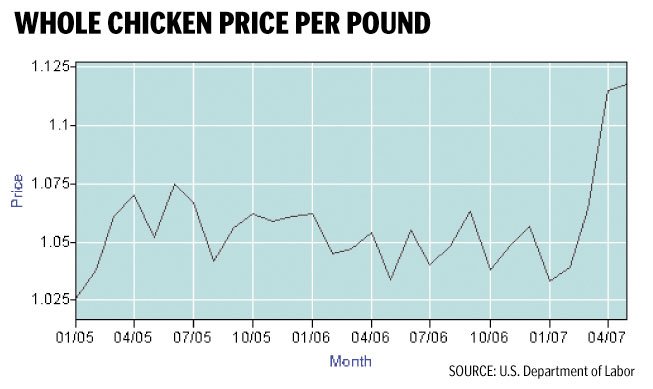One hundred dollars used to buy Ramon Tomas many bags of
groceries but today
”
it’s only one,
”
he said. The feeling of getting less while paying the same is
common at gas stations, but what does one do when it starts to hit
grocery stores?
BY perry Shirley staff writer
Gilroy – One hundred dollars used to buy Ramon Tomas many bags of groceries but today “it’s only one,” he said. The feeling of getting less while paying the same is common at gas stations, but what does one do when it starts to hit grocery stores?
“We are low income but we have to eat,” Tomas said while shopping at Gilroy’s Nob Hill Foods with his wife. “So even if it’s expensive we work hard so we put food on the table.”
While store and section managers at local grocery stores such as Nob Hill and Safeway repeatedly denied that prices are on the rise, shoppers say they have have felt an increase at the register.
“I’ll buy my fish and meat here but the regular staples I buy at Wal-Mart,” said Kay Wesley, another Nob Hill shopper. “Recently, this place started advertising new low prices. That didn’t last.”
A pound of premium ground beef at Nob Hill that sold last year for $1.99 a pound now sells for $3.49. The store that once offered shoppers six limes for $1, now sells five for $1. Packaged sliced cheese sells for $3 – 50 cents more than a year ago, at Gilroy’s Safeway store. A three-pound bag of frozen beef patties sells for $3 more today.
The reason people are smarting: Inflation in grocery aisles is up by more in the first six months of 2007 than in all of 2006. That means food costs are on track for the largest annual percentage hike since 1980, according to the U.S. Department of Labor. The anticipated 7.5 percent increase would readily outflank the 2.6 percent core inflation rate to date, which excludes food and energy. It’s across every grocery aisle, too, from burgers to bagels, from ducks to dumplings.
As a community outreach educator with St. Joseph’s Family Center working with low-income families in Gilroy, Dennis Grundhoefer has seen many locals strained by the high cost of groceries.
“For families who are in a situation where it’s between rent and food, it’s difficult,” he said. “You can control some things – if you drive a lot obviously you’re affected by the price of gas but we all eat.”
For some consumers, it’s tough to hang on. In Gilroy, St. Joseph’s is seeing a “definite increase ” in the number of bagged lunches and hot dinners it serves to the poor and homeless in the last six months, director David Cox said. Americans are coping, too, simply by food shopping less often. Their average number of grocery store trips each week dipped below two for the first time since the Food Marketing Institute began its annual survey.
Wholesaler such as Costco may be able to save some people money, but don’t work for everyone. Wesley said she lives alone and could not consume enough to make buying in bulk feasible. Likewise, the majority of families Grundhoefer works with are low-income who can’t take advantage of saving from buying in bulk and paying membership fees because “you have to spend more money to save money and if it means more cash output, they can’t do it,” he said.
“It’s quite common that the poor pay more for food than the rich do,” Grundhoefer said.
There are many reasons why prices have risen so dramatically.
“(Prices) are certainly higher than they’ve been the last couple years. It’s difficult to narrow it down to just one factor – I do notice that prices of corn and wheat grain have gone up. The higher gasoline prices certainly affect the distributors. If there is a blight or drought or a freeze…” said Amar Maan, an economist at the U.S. Bureau of Labor Statistics, which tracks grocery store costs in population centers across the country.
The chief culprit is corn, namely so-called No. 2 feed corn, the staple of the breadbasket. In answer to President Bush’s call for greater oil independence, the amount of feed corn distilled into ethanol is expected to double in the next five to six years. Distillation is already sucking up 18 percent of the total crop. The ethanol gambit, in turn, is sending corn prices to historic levels – its producer’s price index has risen by “more than 50 percent,” Mann said. This creates a spillover effect because corn is used to produce ethanol and is used as an important source of feed for livestock.
“If it costs you more to feed your cows and chickens and pigs, the products that are produced from that livestock are more expensive,” Mann said. “When producers have to pay more for those inputs the most logical way for them to recoup those costs it is either by raising prices or reducing their profits.”
But corn alone does not explain the number of products that have become more expensive of late.
There are plenty of natural causes that affect prices. In California, January’s cold snaps and hard freezes, coupled with a shortage of labor ruined an estimated 85 percent of the state’s $1 billion citrus crop.
In the heartland, low yields on winter wheat mean cookies and baguettes are more expensive. Meat costs are up by 15 percent in some regions, in part because of drought that, as in Alabama, caused a cattle sell-off. Milk prices are up in part because of a global shortage, with milk exporters such as New Zealand unable to add capacity and Australia enduring a debilitating drought, even as demand rises in Europe, China and India.
The solution will come on its own but it will take time and it won’t be easy, the economist added.
“These things go in cycles and generally what it means is that farmers will plant more of what crop is needed (but) if you look around the world there isn’t a whole lot more land that you can develop and water is scarce,” Siebert said.
But one standard is back in vogue: the supermarket flier. Newspaper coupons can take 30 percent off the top of the grocery tab, almost wiping out the recent price increases, economists say. Shoppers are also using Web sites such as TheGroceryGame.com and SupermarketGuru.com to search for sales and values across zip codes.
Perry Shirley is a news intern and attends San Francisco State University. The Christian Science Monitor contributed to this report.















